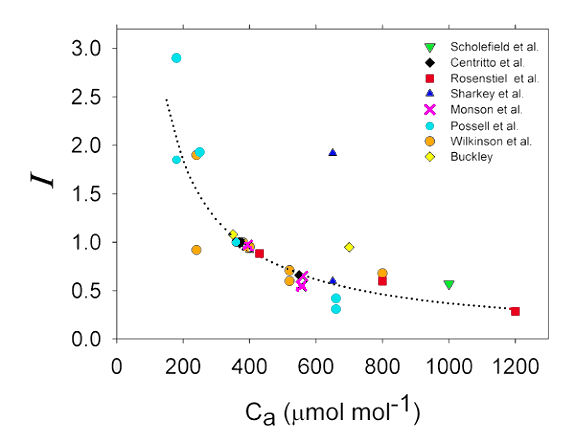Volume 13, Number 19: 12 May 2010
In a paper published in the 17 September 2009 issue of Nature, Kiendler-Scharr et al., as they describe it, "present evidence from simulation experiments conducted in a plant chamber that isoprene can significantly inhibit new particle formation." The significance of this finding derives from the fact (as they also write) that "the most abundant volatile organic compounds emitted by terrestrial vegetation are isoprene and its derivatives, such as monoterpenes and sesquiterpenes," as well as the fact, as described in the "This Issue" abstract section of Nature (p. 311), that "these compounds are involved in the formation of organic aerosols [the "new particles" mentioned by them], which act as 'seeds' for cloud formation and hence as cooling agents via an effect on radiative forcing," plus the explanation presented by Ziemann (2009) -- in a News & Views article that discusses the Kiendler-Scharr et al. paper -- that "clouds formed at higher CCN [cloud condensation nuclei] concentrations have more and smaller drops than those formed at lower concentrations, and so reflect more sunlight and are longer-lived -- effects that, at the global scale, enhance the planetary cooling that counteracts some of the warming caused by greenhouse gases." Hence, if vegetative isoprene emissions were to increase, driven directly by rising temperatures and/or indirectly by warming-induced changes in the species composition of boreal forests (as further suggested by Ziemann), the resulting decrease in CCN concentrations "could lead to increased global-warming trends," as suggested by Kiendler-Sharr in a "Making the Paper" article in the same issue of Nature (p. 313).
Well, the story propounded by these four related items may sound like it delivers a devastating blow to those of us who believe that the propensity of real-world evidence suggests that earth's biosphere is fully capable of maintaining the temperature of the planet within bounds conducive to its own continued existence. However, and as almost an afterthought, Ziemann writes (and rightly so) that consideration should also be given to what he calls "the potential suppression of terpene emissions by elevated carbon dioxide concentrations [italics added]." And when this is done, it is readily evident that the reality of the phenomenon has been well documented, as demonstrated by the multiple sets of observational data plotted in the figure below; and it clearly suggests that rising atmospheric CO2 concentrations will decrease isoprene emissions and thereby increase CCN concentrations and lead to a cooling of the planet, as is also suggested by the findings of many other papers we have reviewed, brief summaries of which are archived under the general heading of Isoprene in our Subject Index.

Figure 1. Field and laboratory observations of leaf isoprene emissions from plants grown in a variety of atmospheric CO2 concentrations (Ca), normalized to a value of unity at Ca = 370 umol mol-1 (= 370 ppm). Adapted from Young et al. (2009).
Yes, there is always another side to the doom-and-gloom prognostications of the world's climate alarmists; and that neglected side is almost always of a beneficent nature.
Sherwood, Keith and Craig Idso
References
Buckley, P.T. 2001. Isoprene emissions from a Florida scrub oak species grown in ambient and elevated carbon dioxide. Atmospheric Environment 35: 631-634.
Centritto, M., Nascetti, P., Petrilli, L., Raschi, A. and Loreto, F. 2004. Profiles of isoprene emission and photosynthetic parameters in hybrid poplars exposed to free-air CO2 enrichment. Plant, Cell and Environment 27: 403-412.
Kiendler-Scharr, A., Wildt, J., Dal Maso, M., Hohaus, T., Kleist, E., Mentel, T.F., Tillmann, R., Uerlings, R., Schurr, U. and Wahner, A. 2009. New particle formation in forests inhibited by isoprene emissions. Nature 461: 381-384.
Monson, R.K., Trahan, N., Rosenstiel, T.N., Veres, P., Moore, D., Wilkinson, M., Norby, R.J., Volder, A., Tjoelker, M.G., Briske, D.D., Karnosky, D.F. and Fall, R. 2007. Isoprene emission from terrestrial ecosystems in response to global change: minding the gap between models and observations. Philosophical Transactions of the Royal Society A 365: 1677-1695.
Possell, M., Hewitt, C.N. and Beerling, D.J. 2005. The effects of glacial atmospheric CO2 concentrations and climate on isoprene emissions by vascular plants. Global Change Biology 11: 60-69.
Rosentiel, T.N., Potosnak, M.J., Griffin, K.L., Fall, R. and Monson, R.K. 2003. Increased CO2 uncouples growth from isoprene emission in an agriforest ecosystem. Nature 421: 256-259.
Scholefield, P.A., Doick, K.J., Herbert, B.M.J., Hewitt, C.N.S., Schnitzler, J.-P., Pinelli, P. and Loreto, F. 2004. Impact of rising CO2 on emissions of volatile organic compounds: isoprene emission from Phragmites australis growing at elevated CO2 in a natural carbon dioxide spring. Plant, Cell and Environment 27: 393-401.
Sharkey, T.D., Loreto, F. and Delwiche, C.F. 1991. High carbon dioxide and sun/shade effect on isoprene emissions from oak and aspen tree leaves. Plant, Cell and Environment 14: 333-338.
Wilkinson, M., Monson, R.K., Trahan, N., Lee, S., Brown, E., Jackson, R.B., Polley, H.W. and Fall, R. 2009. Isoprene emission rate as a function of atmospheric CO2 concentration. Global Change Biology 15: 1189-1200.
Young, P.J., Arneth, A., Schurgers, G., Zeng, G. and Pyle, J.A. 2009. The CO2 inhibition of terrestrial isoprene emission significantly affects future ozone projections. Atmospheric Chemistry and Physics 9: 2793-2803.
Ziemann, P.J. 2009. Thwarting the seeds of clouds. Nature 461: 353-354.




